7 Ways to Save the Microsoft Surface
It has a more dynamic interface. It has Office inside. It can run two apps on the same screen. And it has a USB port and a built-in kickstand. The iPad has none of these things, and the Microsoft Surface does. So why does Microsoft's first tablet already seem to be on the ropes? According to one estimate, Microsoft is slated to sell only between 500,000 to 600,000 Surfaces running Windows RT during the December quarter, well below expectations. To put this anemic performance in perspective, Apple moved 3 million new iPads and iPad minis in three days.
Hope isn't lost for the Surface. There are some things Microsoft can do immediately to boost sales, as well as some changes the company should make to ensure that there is a second and third Surface. Given that this tablet is a beacon for Windows 8 adoption, there couldn't be more at stake. So listen up, Steve Ballmer & friends.
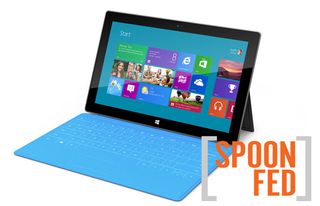
1. Bundle the Touch Cover For Free
When you think about it, the Surface ads are just a tease. Microsoft showcases its Touch Cover in all of the commercials for its tablet, which attaches magnetically to the slate and offers a surprisingly good typing experience given that there's no physical travel. And, like the iPad's Smart Cover, the screen turns on and off like a refrigerator door light when you open and close the cover. There's just one problem. Microsoft charges $599 for the Surface if you want the Touch Cover, $100 more than the tablet by itself. Want a color other than black? You'll have to pony up $119. If you look at iSuppli's teardown of the Surface's components and manufacturing costs, Microsoft is making $215 on each device, making this tablet more profitable than the iPad. But this margin is meaningless if no one is buying. At least through the holidays, the Touch Cover should be free.
More: Top 10 Microsoft Surface Cases
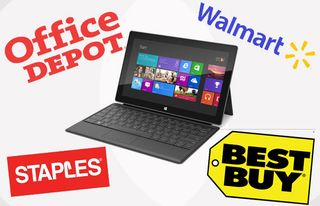
2. Widen the Distribution, Pronto
Let's say you were excited by what the Surface has to offer. You'd want to run out and try one before you buy, right? Well, unless you happen to live within range of a few dozen Microsoft stores, you're out of luck. The good news is that the Surface will soon become more widely available. According to Microsoft, the Surface will we sold in more retail stores starting in mid-December. Staples is among the first partners for this bigger push, and more are sure to follow. Potentially peeved partners be damned, this is the right move for Microsoft. You can't blanket the airwaves with ads and then not make it easy for people to pick a Surface up or at least test drive it. As far as I'm concerned, hitting Best Buy and other big-box stores will only be good for partners, because at least there's the potential for shoppers to look past the iPad aisle.
More: 12 Hottest Holiday Tablets
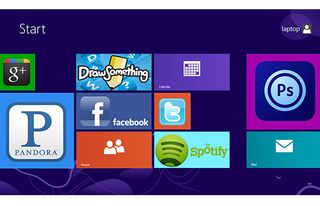
3. Amp Up the Apps
Recently Microsoft caused a bit of a stir when a Facebook live tile was spotted in a Surface banner ad. As it turns out, the tile was just a shortcut to the website. Never mind the fact that this ad is misleading. Where the heck is the Windows 8 Facebook app? Or the Twitter app? Or Spotify. Or Draw Something? You get the picture. Despite the fact that the Windows Store stocks some compelling apps, such as "Angry Birds Star Wars," Netflix and UrbanSpoon, there are lots of holes in the lineup. Microsoft is trying to court developers, hosting app labs for them in 30 technology and design hubs around the world. But the clock is ticking.
Stay in the know with Laptop Mag
Get our in-depth reviews, helpful tips, great deals, and the biggest news stories delivered to your inbox.
More: Top 25 Windows 8 Apps
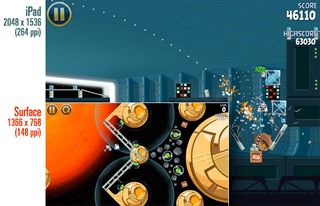
4. Supply a Sharper Screen
Microsoft makes a big deal about the ClearType display on its Surface tablet, arguing that the sub-pixel rendering on this 1366 x 768-pixel screen makes for sharper images than what you'll find on competing tablets. In reality, the iPad's Retina display (2048 x 1536) runs circle around the Surface. Although the Surface and iPad have comparable brightness (373 versus 383 lux), the Retina display is way sharper, whether you're viewing high-resolution photos or text. The iPad also offered warmer and more saturated colors when viewing the same videos. The good news is that the Surface Pro will bump the resolution up to 1920 x 1080 pixels. But Microsoft should include this resolution on the RT version as well without charging a premium. After all, you can pick up an Android tablet like the ASUS Transformer Pad Infinity with a 1920 x 1200-pixel screen for $499. Microsoft also needs to ensure that icons and other items don't shrink at full HD to the point they're nearly impossible to target with a finger. The Acer Iconia Tab A700 is a great example of how high-def can be hard on the eyes.
More: Top 10 Tablets Available Now
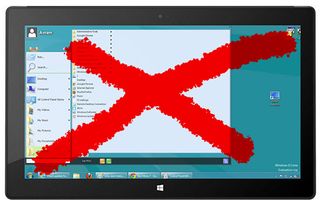
5. Ditch the Desktop on Windows RT
I'm certainly not the first to suggest this, but perhaps hearing it from more and more critics will drive the message home. Microsoft needs to stick with the Modern (formerly Metro) interface on Windows RT devices like the Surface. That means no desktop. You shouldn't have two completely different computing environments on the same tablet. In order to unify the user experience, though, Microsoft will need to get Office to work within the Modern environment, as well as create a file manager that works in that mode. Microsoft would also need to beef up the settings menu in the Modern UI to obviate the need for a desktop.
More: Microsoft Surface with Windows RT Review
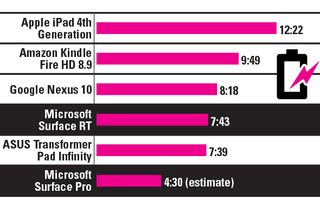
6. Lose Core i5 and Beef Up Battery Life
The Surface with Windows RT lasted a decent but unspectacular 7 hours and 43 minutes in our battery test, which involves continuous Web surfing over Wi-Fi on 40 percent brightness. Sadly, Microsoft says that the upcoming Windows 8 Pro version will have half as much endurance. That would mean less than 4 hours of juice, which is unacceptable for a tablet. Why does the Surface Pro have such a pitiful rated runtime? Part of the blame goes to the Core i5 processor under the hood, which simply guzzles more power than the ARM chip inside the RT version of this tablet. If I were Microsoft I would switch gears to an Atom CPU. This would allow users to still run desktop apps while offering longer battery life. Sure, you'll give up some horsepower, but the Surface isn't really designed to be your primary PC. Besides, an Atom-powered Surface Pro would also likely be cheaper. For example, Samsung charges $699 for its Atom-enabled Ativ Smart PC, and $899 with the keyboard dock. The Surface Pro will start at $899 without a keyboard.
More: The Longest-Lasting Laptops
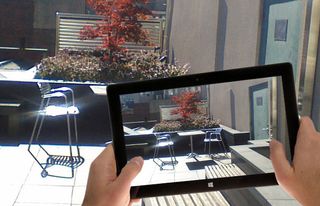
7. Offer Better Cameras or Don't Bother
Our review probably sums it up best: “If you're planning to take pictures with your tablet, don't plan on buying the Surface.” Ouch. The front and rear 1-megapixel cameras on Microsoft's tablet disappointed in our tests. The rear camera took blurry photos with washed-out colors, while the front camera captured dull and noisy. What's the point of Microsoft owning Skype if you can take full advantage of the service on its hallmark tablet?
Editor-in-chief Mark Spoonauer directs LAPTOP's online and print editorial content and has been covering mobile and wireless technology for over a decade. Each week Mark's SpoonFed column provides his insights and analysis of the biggest mobile trends and news. You can also follow him on Twitter.
